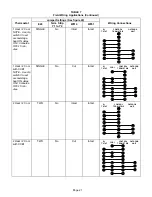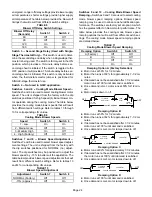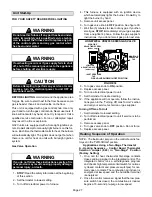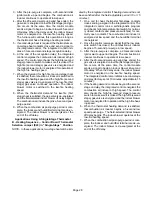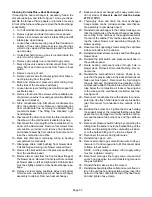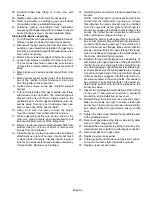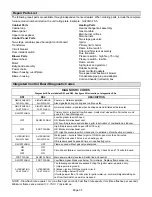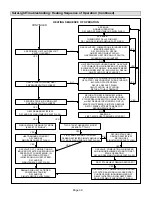
Page 33
Cleaning DuralokPlus
TM
Heat Exchanger
If cleaning the heat exchanger is necessary, follow the
procedures below, and refer to figure 1 while you disasĆ
semble the furnace. Place papers or protective covering
in front of the furnace while you remove the heat exchangĆ
er assembly.
1 - Turn off electrical and gas power supplies to furnace.
2 - Remove upper and lower furnace access panels.
3 - Remove four screws around air intake fitting and lift
intake pipe up and away.
4 - Loosen hose clamp securing top of flue transition to
bottom of flue collar. Remove screw securing flue
collar to top cap and lift exhaust pipe and flue collar
up and away.
5 - If electrical field makeĆup box is located inside the
unit, it must be removed.
6 - Remove gas supply line connected to gas valve.
7 - Mark all gas valve wires and disconnect them from
valve. Mark and remove wires from flame rollĆout
switch.
8 - Remove top cap of unit.
9 - Remove sensor wire from SureLight control. DisconĆ
nect 2Ćpin plug from the ignitor.
10 - Mark and disconnect pressure switch tubing from
both sides of the pressure switch(es).
11 - Loosen two screws holding gas manifold support at
vestibule panel.
12 - Remove four burner box screws at the vestibule panĆ
el and remove burner box and gas valve/manifold asĆ
sembly with bracket.
13 - Drain condensate trap. Disconnect condensate line
from the outside of unit. Remove condensate line
from condensate trap by turning the adapter fitting
counterclockwise. The fitting has standard right
hand threads.
14 - Disconnect the drain hose from the flue transition to
the elbow on the cold header (collector) box trap.
15 - Disconnect the 3Ćpin plug from the combustion air inĆ
ducer at the blower deck. Remove four screws from
combustion air inducer and remove flue transition
and inducer assembly from cabinet. Take care not to
lose the combustion air orifice.
16 - Mark and disconnect remaining wiring to heating
compartment components.
17 - Disengage strain relief bushing from blower deck.
Pull bushing and wiring into blower compartment.
18 - Remove the limit switch and the pressure switch(es)
from the vestibule panel.
19 - Remove two screws from the front cabinet flange at
the blower deck. Remove front screws from cabinet
at blower deck on left and right sides. Cabinet sides
must be slightly spread to clear heat exchanger pasĆ
sage.
20 - Remove screws along vestibule sides and bottom
which secure vestibule panel and heat exchanger
assembly to cabinet. Remove heat exchanger.
21 - Back wash heat exchanger with soapy water soluĆ
tion or steam.
If steam is used it must be below
275°F (135°C).
22 - Thoroughly rinse and drain the heat exchanger.
Soap solution can be corrosive so take care that enĆ
tire assembly is completely rinsed.
23 - Reinstall heat exchanger in the cabinet making sure
that the clamshells of the heat exchanger assembly
are resting in the notches of the support located at
the rear of the cabinet. This can be viewed by removĆ
ing the indoor blower and examining through the
blower opening.
24 - Resecure the supporting screws along the vestibule
sides and bottom to the cabinet.
25 - Reinstall cabinet screws on sides and front flange at
blower deck.
26- Reinstall the limit switch and pressure switches on
the vestibule panel.
27 - Route heating component wires through hole in
blower deck. Reinsert strain relief bushing. ReconĆ
nect wires.
28 - Reinstall the combustion air inducer. Check to enĆ
sure that the plastic orifice in the inducer inlet has not
fallen out. See figure 1. Reconnect the 3Ćpin plug to
the wire harness. Reinstall the flue transition in the
cabinet and reattach the drain tube. Route the drain
tube below the combustion air inducer housing and
to the elbow on the cold header (collector) box trap.
See figure 31.
29 - Reconnect condensate line with adapter to condenĆ
sate trap. Use fresh Teflon tape to ensure a leak-free
joint. Reconnect to condensate line outside of the
unit.
30 - Reinstall the burner box. Tighten the screws holding
the support bracket. It is important that the glass fiber
gasket not be damaged so it will provide a continuĆ
ous seal between the burner box and the vestibule
panel.
31 - Reconnect pressure switch tubing by connecting the
tubing from the burner box to the barbed fitting on the
bottom and the tubing from the combustion air inducĆ
er to the barbed fitting on the top. See figure 31.
32 - Reconnect the sensor and ignitor wires.
33 - Reinstall top cap on unit.
34 - Reconnect wiring to gas valve. Brown wire to HI, yelĆ
low wire to C and orange wire to M. Reconnect wires
to flame rollĆout switch.
NOTE - Unit is polarityĆsensitive. 120V supply wiring
must be installed correctly.
35 - Reconnect main gas line to gas valve. Use second
wrench on gas valve to avoid transferring torque to
the gas manifold.
36 - Reinstall field makeĆup box if removed.
37 - Reinstall exhaust pipe/flue collar and secure flue colĆ
lar on the unit top cap using existing screw. Insert the
bottom of the flue collar into the top of the flue transiĆ
tion and tighten hose clamp.



